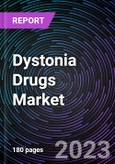10% Free customization
Dystonia can be referred to a movement disorder featured by involuntary muscle contractions which cause slow repetitive movements or abnormal postures. These muscle contractions result in unusual muscle movements and body postures. There are various types of dystonia affecting a single muscle, or a group of muscles or may affect muscles all over the body. The rise of the dystonia drugs market is projected to be driven by high potential in untapped, rising markets, owing to availability of developing healthcare infrastructure, rise in unmet healthcare needs, and rise in demand for advanced healthcare facilities. Additionally, surge in prevalence of dystonia and also surge in incidence of other neurological disorders having dystonia symptoms is propelling the growth of the market. This increase in incidence of dystonia, augments the demand for dystonia treatment medications which further accelerates the growth of the dystonia drugs market share. However, the huge costs incurred in the treatment of dystonia may limit the market growth. The Dystonia Drugs Market is anticipated to grow at a rate of 5.3% CAGR by 2027.This report comes with 10% free customization, enabling you to add data that meets your specific business needs.
Dystonia Drugs Market by Drug Type
- Anticonvulsants drugs
- Others
- Dopaminergic agents
- GABAergic agents
Dystonia Drugs Market by Route of Administration
- Oral
- Injectable
Dystonia Drugs Market by Distribution Channel
- Hospital Pharmacies
- Online Providers
- Drug Stores and Retail Pharmacies
Dystonia Drugs Market by Geography
- North America
- Europe
- Asia Pacific
- Rest of the World
As per the Market by route of administration, the market is bifurcated into Oral and Injectable. Among them the injectable segment has the substantial share in the market. This is due to the increase in innovations in parenteral dosing and increased research and development for botulinum injections. Absorption of the medication, particularly aqueous solutions, is rapid and uniform. There is a swift commencement of effect compared to the oral and subcutaneous methods.
The distribution channel segment is classified into Hospital Pharmacies, Online Providers and Drug Stores and Retail Pharmacies. The drug stores & retail pharmacies segment is accounted for the maximum share in the market. This is because of its substantial chain of distribution networks and it being the oldest and most easy channel for providing drugs to consumers. Retail pharmacists prepare and dispense drugs, advise consumers on the proper use of medications, and inform them of possible drug interactions.
In Market by geographical analysis, the North America region has acquired a substantial share in the market. The surge in incidences of dystonia coupled with surge in prevalence of other neurological conditions causing dystonia in U.S. population and other major nations is the key factor for augmenting demand for dystonia drugs in North America.
The federal government influences private investment on research and development through programs which augment the demand for prescription drugs, through policies (such as investment for basic research and regulations on what must be demonstrated in clinical trials) which affect the supply of new medicines, and through policies (such as vaccine recommendations) which affect both supply and demand. The surging R&D in the pharmaceutical industry worldwide is likely to improve the effectiveness of dystonia drugs and their utilization, thereby fueling the global market growth.
This report includes the key vendors operating in the market- Teva Pharmaceuticals Industries Ltd., F.Hoffmann-La Roche Ltd., Merz Pharma GmbH & Co. KGaA, Ipsen Pharma Biotech SAS, Hameln Pharma Gmbh (Siegfried Group, LLP), AbbVie, Inc., Amneal Pharmaceuticals, Inc., Wellona Pharma, Pfizer, Inc. and Novartis AG.
Henceforth, the dystonia drugs market is anticipated to witnessing a significant in the estimated time span. Since, compared to all treatments the drugs are considered to be the best option for the dystonia. The drugs are deemed to provide the quick and complete relief for the ailment.
Key reasons to purchase the report:
- This report of Dystonia Drugs market depicts the geographical regions and sub segment which is projected to have the rapid growth and having the major share.
- This study implies the factors which are compelling and restricting the market growth and the providing pitfalls and opportunities for the Dystonia Drugs market.
- This report also consists of information of the market’s leading vendors and their position in the market.
- This report also consists of constant market developments and innovations taking place in the Dystonia Drugs market.
Table of Contents
1. Executive Summary11. Analyst Opinion
2. Industry Outlook
3. Market Snapshot
4. Market characteristics
5. Drug Type: Market Size & Analysis
6. Route of Administration: Market Size & Analysis
7. Distribution Channel: Market Size & Analysis
8. Geography: Market Size & Analysis
9. Competitive Landscape
10. Vendor Profiles
12. Annexure
Companies Mentioned
- Teva Pharmaceuticals Industries Ltd.
- F.Hoffmann-La Roche Ltd.
- Merz Pharma GmbH & Co. KGaA
- Ipsen Pharma Biotech SAS
- Hameln Pharma Gmbh (Siegfried Group, LLP)
- AbbVie, Inc.
- Amneal Pharmaceuticals, Inc.
- Wellona Pharma
- Pfizer, Inc.
- Novartis AG








